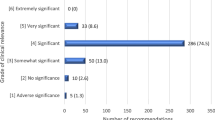Abstract
Rationale
Objective
To evaluate in a community setting the extent of and parameters related with awareness of side effects of medications by health consumers.
Methods
We performed in-house interviews in an entire community. The population of the community of Chalki, Greece, was surveyed. Detailed information was recorded on all medications possessed by each individual. The main outcome measure was awareness of medication side effects.
Results
A total of 1079 medications were recorded among 279 subjects. Among 180 subjects for whom direct information was available, and who possessed at least one medication only 47 (26%) were aware of the side effects of at least one of their medications. Side effects awareness was more frequent in subjects who had experienced some adverse event themselves (76%), in those with completed university education (67%), ex-smokers (46%), housewives (45%), and never married adults (41%) and was less frequent in more permanent island residents (odds ratio 0.76 per 10% of lifetime spent in the island) and economic immigrants (0%). Side effects awareness existed for only 8% of the possessed medications and was more frequent when an adverse event had been experienced (54%), for medications not provided locally initially (28%), and for medications for joint and musculoskeletal problems (15%). Awareness rates were unrelated to availability of prescription, specialist involvement, or follow-up by a physician concerning the specific medication.
Conclusions
Awareness of side effects was infrequent in this community setting and was determined mostly by live experiences of adverse events and social parameters. There is a need to improve the dissemination of adequate safety information among consumers in the ambulatory use of pharmaceuticals.
Similar content being viewed by others
References
Kohn R, White KR (1976) Health care: an international study. Oxford University Press, Oxford
Stolley PD, Becker MH, McEvilla JD, Lasagna L, Gainor M, Sloane LM (1972) Drug prescribing and use in an American community. Ann Intern Med 76:537–540
Kshirsagar MJ, Langade D, Patil S, Patki PS (1998) Prescribing patterns among medical practitioners in Pune, India. Bull World Health Organ 76:271–275
Lai MS, Chu CS, Lin SH, Lin MS (1995) Prescribing patterns in primary health care in Taiwan. Int J Clin Pharmacol Ther 33:437–441
Walley T, Wilson R, Bligh J (1995) Current prescribing in primary care in the UK. Effects of the indicative prescribing scheme and GP fundholding. Pharmacoeconomics 7:320–331
Jorgensen TM, Isacson DG, Thorslund M (1993) Prescription drug use among ambulatory elderly in a Swedish municipality. Ann Pharmacother 27:1120–1125
Klaukka T, Makela M, Sipila J, Martikainen J (1993) Multiuse of medicines in Finland. Med Care 31:445–450
Thomas HF, Sweetnam PM, Janchawee B, Luscombe DK (1999) Polypharmacy among older men in South Wales. Eur J Clin Pharmacol 55:411–415
Willcox SM, Himmelstein DU, Woolhandler S (1994) Inappropriate drug prescribing for the community-dwelling elderly. JAMA 272:292–296
Zhan C, Sangl J, Bierman AS, Miller MR, Friedman B, Wickizer SW, et al (2001) Potentially inappropriate medication use in the community-dwelling elderly. JAMA 286:2823–2829
Morgan TM (2001) The economic impact of wasted prescription medication in an outpatient population of older adults. J Fam Pract 50:779–781
Ernst ME, Kelly MW, Hoehns JD, Swegle JM, Buys LM, Logemann CD, et al (2000) Prescription medication costs: a study of physician familiarity. Arch Fam Med 9:1002–1007
Walzak D, Swindells S, Bhardwaj A (1994) Primary care physicians and the cost of drugs: a study of prescribing practices based on recognition and information sources. J Clin Pharmacol 34:1159–1163
Reichert S, Simon T, Halm EA (2000) Physicians' attitudes about prescribing and knowledge of the costs of common medications. Arch Intern Med 160:2799–2803
Ibanez L, Laporte JR, Carne X (1991) Adverse drug reactions leading to hospital admission. Drug Saf 6:450–459
Ioannidis JP, Lau J (2001) Evidence on interventions to reduce medical errors: an overview and recommendations for future research. J Gen Intern Med 16:325–334
Beers MH (1997) Explicit criteria for determining potentially inappropriate medication use by the elderly: an update. Arch Intern Med 157:1531–1536
Kjellgren KI, Svensson S, Ahlner J, Saljo R (1998) Antihypertensive medication in clinical encounters. Int J Cardiol 64:161–169
Katz JN, Daltroy LH, Brennan TA, Liang MH (1992) Informed consent and the prescription of nonsteroidal antiinflammatory drugs. Arthritis Rheum 35:1257–1263
Calkins DR, Davis RB, Reiley P, Phillips RS, Pineo KL, Delbanco TL, et al (1997) Patient-physician communication at hospital discharge and patients' understanding of the postdischarge treatment plan. Arch Intern Med 157:1026–1030
Britten N, Stevenson FA, Barry CA, Barber N, Bradley CP (2000) Misunderstandings in prescribing decisions in general practice: qualitative study. BMJ 320:484–488
Ioannidis JP, Lau J (2001) Completeness of safety reporting in randomized trials: an evaluation of 7 medical areas. JAMA 285:437–443
Ioannidis JP, Contopoulos-Ioannidis DG (1998) Reporting of safety data from randomized trials. Lancet 352:1752–1753
Ioannidis JP, Lau J (2002) Improving safety reporting from randomised trials. Drug Saf 25:77–84
Ernst E, Pittler MH (2001) Systematic reviews neglect safety issues. Arch Intern Med 161:125–126
Ziegler DK, Mosier MC, Buenaver M, Okuyemi K (2001) How much information about adverse effects of medication do patients want from physicians? Arch Intern Med 161:706–713
Acknowledgements
We are thankful to Prof. Haralampos M. Moutsopoulos, former President of the Hellenic Organization for Medicines, for his encouragement and insightful comments on the manuscript. We also thank the Municipality of Chalki and Dr. Georgia Christidi for offering valuable help in organizing the survey.
Author information
Authors and Affiliations
Corresponding author
Rights and permissions
About this article
Cite this article
Papanikolaou, P.N., Ioannidis, J.P.A. Awareness of the side effects of possessed medications in a community setting. Eur J Clin Pharmacol 58, 821–827 (2003). https://doi.org/10.1007/s00228-003-0570-x
Received:
Accepted:
Published:
Issue Date:
DOI: https://doi.org/10.1007/s00228-003-0570-x




